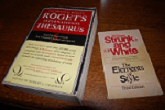A few Rules of English Grammar

Create a Robust Paragraph
Recall what your grammar teacher told you many times: Use active verbs. Do you think active is positive, and outgoing and well, healthy?
Does a passive verb have an unhealthy side because it's, well, inactive? No. Don't think passive adds an unhealthy slant. Sometimes, we need a passive verb. So, too, sometimes an entire paragraph needs special emphasis or a change of momentum. In the end, a paragraph of both active and passive verbs remains healthy.
Think about what you want to emphasize when you write a sentence. For example, this sentence has an active verb: The dog runs fast. The event describes the activity of a dog at the present time.
Take note of the verb in this sentence: The army was ordered to clear the snow from the primary streets. The reader has learned important information about snow removal in a sentence with a passive verb.
Consider this sentence: The office is closed. The verb "is" represents a linking action. It's neither active nor passive.
A predicate adjective follows a linking verb. For example, when you say: This coffee is good. "Good" is the adjective that links to the word coffee. A linking verb can be plural as this sentence illustrates: The tomatoes are good.
In his book, The Sense of Style, Stephen Pinker writes about the role of the passive.
They may be overused, and often they are badly used, but that does not mean they should not be used at all.